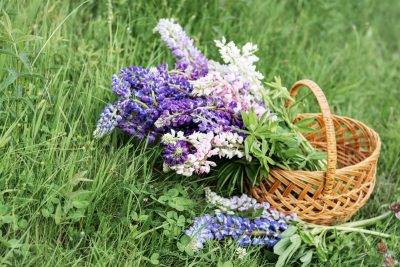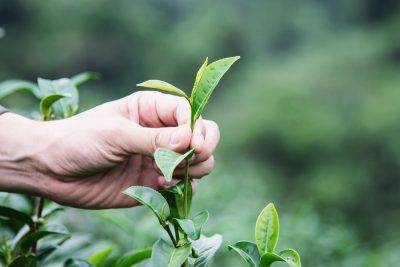Thevalue of medicinal plants is determined by the quality and quantity of the active substances they contain. So when collecting medicinal plants, we must first of all be aware of which part of the plant is to be collected and which part of the plant contains the active substance. Some plants contain them in the leaves, others in the roots or fruits. Thus, for example, the active ingredient is found in the leaves and roots of the nightshade (Atropa Belladonna L. ) and it is therefore unnecessary to collect the stem or flower. Peppermint (Mentha piperita L. ) does not contain essential oil in its roots, so collecting the root would be a waste of effort. Which part of the plant should be collected and which is valuable for the active ingredient is discussed in detail in the description of the plants, but guidance is also given by the trade itself, which will always specify which part of the plant is required. The following parts of the plant are distinguished in terms of collection and use: 1. Theroot = radix is in the trade – botanically incorrectly, – all the underground parts of the plant. The parts of the plant classified under this generic name include, in addition to the root, all parts of the plant: Root stem = rhizoma and tuber = tuber. 2.Leaf = folium, by which name the leaves are generally understood in trade; the plural folia is also used to denote the leaves. 3.Flower = flos, flores is used in herbal terminology to refer not only to the individual flowers but also to the inflorescences, – but it is also the name generally used to designate petals: e.g. the inflorescence of lime tree, chamomile is sold under the name flores, as are the petals of poppy or wheat flower. Petals are also called flores sine calyicibus to distinguish them from flowers. 4. The namefruit = fructus is used in the trade not only to designate the fruit of the plant, but also, often incorrectly, the seeds. The correct name for the seed is semen. 5. The nameherb = herba is used to designate the entire part of the plant above ground, including the stem, leaves and developing flowers. 6.Bark = cortex is the bark covering the branches and trunks of woody plants.
Which part of the plant should be collected and which is valuable for the active ingredient is discussed in detail in the description of the plants, but guidance is also given by the trade itself, which will always specify which part of the plant is required. The following parts of the plant are distinguished in terms of collection and use: 1. Theroot = radix is in the trade – botanically incorrectly, – all the underground parts of the plant. The parts of the plant classified under this generic name include, in addition to the root, all parts of the plant: Root stem = rhizoma and tuber = tuber. 2.Leaf = folium, by which name the leaves are generally understood in trade; the plural folia is also used to denote the leaves. 3.Flower = flos, flores is used in herbal terminology to refer not only to the individual flowers but also to the inflorescences, – but it is also the name generally used to designate petals: e.g. the inflorescence of lime tree, chamomile is sold under the name flores, as are the petals of poppy or wheat flower. Petals are also called flores sine calyicibus to distinguish them from flowers. 4. The namefruit = fructus is used in the trade not only to designate the fruit of the plant, but also, often incorrectly, the seeds. The correct name for the seed is semen. 5. The nameherb = herba is used to designate the entire part of the plant above ground, including the stem, leaves and developing flowers. 6.Bark = cortex is the bark covering the branches and trunks of woody plants.  Whencollecting medicinal plants, our work is always directed to the collection of one of these parts of the plant , and the main care must be taken to collect them at a time and in a manner that will give them the most active substances and preferably in their unaltered form. The correct choice of the collection period is very important to achieve this objective, and the collection of plant parts at the time of their full development is a guideline. The following practical rules are applicable: Roots and other parts of plants included under this collection name should be collected in early spring or late autumn when leaves and flowers are in bud; flowers should be collected at flowering, before full opening, fruits and seeds after ripening, grasses at the beginning of flowering, and bark in early spring, before foliage development. As well as choosing the right time to collect, we also need to be careful about what time of day to collect the plant parts. As a general rule, it should always be collected in dry weather, otherwise the plant parts will contain so much moisture that it will be very difficult or impossible to dry them properly, which could lead to the decomposition of the active substances. The flowers and leaves are also not suitable for collection in bright sunny weather and should therefore be collected in the early morning hours, after the dew has dried. Roots and underground parts of plants in general can be collected at any time of the day, but care should be taken to ensure that they are well cleaned of any earthy particles adhering to them after digging them out of the ground and then spread out to dry. Theleaves are collected in one of two ways: either by carefully pruning or pinching the individual leaves, taking care not to get any stems on the leaves, or by cutting off the whole stem of the plant and removing the leaves from the stems collected, with the stems in their stalks. The former is the more valuable method and, as it is possible to collect large quantities with little practice, it is also more economical.
Whencollecting medicinal plants, our work is always directed to the collection of one of these parts of the plant , and the main care must be taken to collect them at a time and in a manner that will give them the most active substances and preferably in their unaltered form. The correct choice of the collection period is very important to achieve this objective, and the collection of plant parts at the time of their full development is a guideline. The following practical rules are applicable: Roots and other parts of plants included under this collection name should be collected in early spring or late autumn when leaves and flowers are in bud; flowers should be collected at flowering, before full opening, fruits and seeds after ripening, grasses at the beginning of flowering, and bark in early spring, before foliage development. As well as choosing the right time to collect, we also need to be careful about what time of day to collect the plant parts. As a general rule, it should always be collected in dry weather, otherwise the plant parts will contain so much moisture that it will be very difficult or impossible to dry them properly, which could lead to the decomposition of the active substances. The flowers and leaves are also not suitable for collection in bright sunny weather and should therefore be collected in the early morning hours, after the dew has dried. Roots and underground parts of plants in general can be collected at any time of the day, but care should be taken to ensure that they are well cleaned of any earthy particles adhering to them after digging them out of the ground and then spread out to dry. Theleaves are collected in one of two ways: either by carefully pruning or pinching the individual leaves, taking care not to get any stems on the leaves, or by cutting off the whole stem of the plant and removing the leaves from the stems collected, with the stems in their stalks. The former is the more valuable method and, as it is possible to collect large quantities with little practice, it is also more economical.  Flowers and inflorescences should always be collected without the stalk (at flowering). Various types of shears are used for this purpose. When collecting both leaves and flowers, care must be taken not to crush the leaves and flowers in the collection bag or basket, so that they do not become saturated and fragment. Thefruits and seeds are collected according to their quality. The larger seeds are picked one by one, the smaller seeds are trimmed and separated by threshing or threshing. The fruits and seeds which, when ripe, easily sprout are mowed off the stalk before they are fully ripe and hung upside down in the drying room to dry. Thegrasses are harvested by mowing the stems of the plants directly above the ground. Care must also be taken not to crush the grasses in the collection bag or basket. The bark is cut off the woody parts in a circle with suitable curved knives. The general rules for collecting medicinal plants, as we have seen above, are all aimed at the most economical use of the plants in terms of their active ingredients, drying and possibly sale. In addition to achieving the active substances, when collecting medicinal plants, we must also take into account that no predatory farming in herb collection areas. With this in mind, we must always bear in mind that the collection area is not only needed for one year, but permanently. Therefore, for example, where flowers from trees are to be collected, – do not break or destroy beautiful branches, but to pinch the individual flowers separately, even if it involves more difficult work, and this more arduous work will pay off in terms of the reward of a successful collection in future years. Where there are larger quantities of roots, not to destroy them completelybut see to it that they are propagated next year. As a health precaution, it is essential to avoid touching your face while collecting herbs and to wash your hands well after you have finished collecting. Source: Dr. Ferenc Darvas and Dr. Gyula Magyary-Kossa,Domestic herbs, their production, marketing, effects and medicinal uses
Flowers and inflorescences should always be collected without the stalk (at flowering). Various types of shears are used for this purpose. When collecting both leaves and flowers, care must be taken not to crush the leaves and flowers in the collection bag or basket, so that they do not become saturated and fragment. Thefruits and seeds are collected according to their quality. The larger seeds are picked one by one, the smaller seeds are trimmed and separated by threshing or threshing. The fruits and seeds which, when ripe, easily sprout are mowed off the stalk before they are fully ripe and hung upside down in the drying room to dry. Thegrasses are harvested by mowing the stems of the plants directly above the ground. Care must also be taken not to crush the grasses in the collection bag or basket. The bark is cut off the woody parts in a circle with suitable curved knives. The general rules for collecting medicinal plants, as we have seen above, are all aimed at the most economical use of the plants in terms of their active ingredients, drying and possibly sale. In addition to achieving the active substances, when collecting medicinal plants, we must also take into account that no predatory farming in herb collection areas. With this in mind, we must always bear in mind that the collection area is not only needed for one year, but permanently. Therefore, for example, where flowers from trees are to be collected, – do not break or destroy beautiful branches, but to pinch the individual flowers separately, even if it involves more difficult work, and this more arduous work will pay off in terms of the reward of a successful collection in future years. Where there are larger quantities of roots, not to destroy them completelybut see to it that they are propagated next year. As a health precaution, it is essential to avoid touching your face while collecting herbs and to wash your hands well after you have finished collecting. Source: Dr. Ferenc Darvas and Dr. Gyula Magyary-Kossa,Domestic herbs, their production, marketing, effects and medicinal uses
